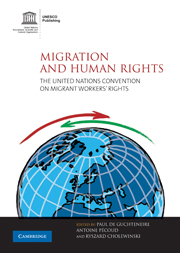Book contents
- Frontmatter
- Contents
- List of figures
- List of tables
- Notes on contributors
- Abbreviations
- 1 Introduction: The UN Convention on Migrant Workers' Rights
- PART I
- PART II
- 7 Obstacles to, and opportunities for, ratification of the ICRMW in Asia
- 8 Obstacles to ratification of the ICRMW in Canada
- 9 Mexico's role in promoting and implementing the ICRMW
- 10 Migrants' rights after apartheid: South African responses to the ICRMW
- 11 Policy on the ICRMW in the United Kingdom
- 12 The French political refusal on Europe's behalf
- 13 Migration and human rights in Germany
- 14 Migration and human rights in Italy: prospects for the ICRMW
- 15 The ICRMW and the European Union
- Annex 1 International Convention on the Protection of the Rights of All Migrant Workers and Members of Their Families Adopted by General Assembly Resolution 45/158 of 18 December 1990
- Annex 2 Ratifications of ILO Conventions 97 and 143 and of ICRMW as at June 2009
- Index
- References
10 - Migrants' rights after apartheid: South African responses to the ICRMW
Published online by Cambridge University Press: 02 December 2010
- Frontmatter
- Contents
- List of figures
- List of tables
- Notes on contributors
- Abbreviations
- 1 Introduction: The UN Convention on Migrant Workers' Rights
- PART I
- PART II
- 7 Obstacles to, and opportunities for, ratification of the ICRMW in Asia
- 8 Obstacles to ratification of the ICRMW in Canada
- 9 Mexico's role in promoting and implementing the ICRMW
- 10 Migrants' rights after apartheid: South African responses to the ICRMW
- 11 Policy on the ICRMW in the United Kingdom
- 12 The French political refusal on Europe's behalf
- 13 Migration and human rights in Germany
- 14 Migration and human rights in Italy: prospects for the ICRMW
- 15 The ICRMW and the European Union
- Annex 1 International Convention on the Protection of the Rights of All Migrant Workers and Members of Their Families Adopted by General Assembly Resolution 45/158 of 18 December 1990
- Annex 2 Ratifications of ILO Conventions 97 and 143 and of ICRMW as at June 2009
- Index
- References
Summary
Introduction
South Africa has a long history of abusing migrants' rights. The migrant labour system to the South African mines, for example, was once described as the ‘most enduring and far-flung oscillating migrant labour system in history [which] laid the foundations of a particularly ruthless system of racial discrimination’ (Crush et al., 1991, p. 3). During the apartheid era, South Africa also failed to accede to any of the major international human rights conventions. In 1994, with the advent of democracy and a new Constitution and Bill of Rights, a rights-based foundation was laid for the protection of all in the country. Over the last decade, South African workers have come to enjoy unprecedented protection through a range of new labour laws (Donnelly and Dunn, 2006). The new South African Government also ratified a significant number of international human rights conventions. However, the ICRMW remains unsigned and unratified. To date, the government has expressed no opinion on the ICRMW, much less voiced opposition to or concerns about its contents. The question addressed in this chapter, then, is whether the failure to ratify is because the government has problems with the Convention itself, like so many other migrant-destination countries (see Taran, 2001; Iredale and Piper, 2003; Piper, 2004; Pécoud and de Guchteneire, 2006).
We argue that the South African failure to ratify is not, in fact, rooted in any principled objection to the ICRMW. To understand the reasons for the response to the Convention in the first ten years after apartheid, it is necessary to appreciate the more general context of attitudes to migrants in post-apartheid South Africa.
- Type
- Chapter
- Information
- Migration and Human RightsThe United Nations Convention on Migrant Workers' Rights, pp. 247 - 277Publisher: Cambridge University PressPrint publication year: 2009
References
- 2
- Cited by

